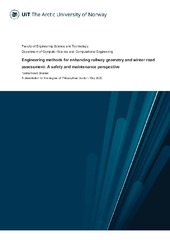| dc.contributor.advisor | Doulgeris, Anthony | |
| dc.contributor.author | Kiærbech, Åshild | |
| dc.date.accessioned | 2019-07-15T11:16:28Z | |
| dc.date.available | 2019-07-15T11:16:28Z | |
| dc.date.issued | 2019-06-03 | |
| dc.description.abstract | Unsupervised clustering methods on remote sensing images have shown good results. However, this type of machine learning needs additional labelling to be an end-to-end classification in the same manner as traditional supervised classification. The automation of the labelling needs further exploration. We want to investigate the robustness of a supervised automatic labelling scheme by comparing a segmentation with additional automatic labelling against a supervised classification method.
Using synthetic aperture radar (SAR) satellite images of sea ice from Sentinel-1, an automatic Expectation Maximization method with a Gaussian mixture model is used for the segmentation, taking into consideration the incidence angle variation within a SAR image. The additional labelling is a likelihood majority vote related to the Mahalanobis distance measure. The Bayesian Maximum Likelihood (ML) is used as the fully supervised reference method. The experiments of comparison are done using various amounts of training data and different percentages of mislabelling in the training data set. The classification results are compared both visually and using classification accuracy.
As training data size increases, the accuracy of the ML method tends to decay faster than for the segment-then-label approach, particularly when sample sizes per class are less than a hundred. As more contamination is introduced, the decay is not distinct, probably due to the large within-class variations in the training set.
Based on the results, the ML method generally gets a higher overall classification accuracy, but there are weak tendencies for the segment-then-label method to be more robust to decreasing training data size and more mislabelling. | en_US |
| dc.identifier.uri | https://hdl.handle.net/10037/15761 | |
| dc.language.iso | eng | en_US |
| dc.publisher | UiT Norges arktiske universitet | en_US |
| dc.publisher | UiT The Arctic University of Norway | en_US |
| dc.rights.accessRights | openAccess | en_US |
| dc.rights.holder | Copyright 2019 The Author(s) | |
| dc.rights.uri | https://creativecommons.org/licenses/by-nc-sa/4.0 | en_US |
| dc.rights | Attribution-NonCommercial-ShareAlike 4.0 International (CC BY-NC-SA 4.0) | en_US |
| dc.subject.courseID | FYS-3941 | |
| dc.subject | VDP::Matematikk og Naturvitenskap: 400::Informasjons- og kommunikasjonsvitenskap: 420::Simulering, visualisering, signalbehandling, bildeanalyse: 429 | en_US |
| dc.subject | VDP::Mathematics and natural science: 400::Information and communication science: 420::Simulation, visualization, signal processing, image processing: 429 | en_US |
| dc.subject | VDP::Matematikk og Naturvitenskap: 400::Matematikk: 410::Analyse: 411 | en_US |
| dc.subject | VDP::Mathematics and natural science: 400::Mathematics: 410::Analysis: 411 | en_US |
| dc.subject | VDP::Matematikk og Naturvitenskap: 400::Matematikk: 410::Statistikk: 412 | en_US |
| dc.subject | VDP::Mathematics and natural science: 400::Mathematics: 410::Statistics: 412 | en_US |
| dc.subject | Automatic labelling | en_US |
| dc.subject | Classification | en_US |
| dc.subject | Image segmentation | en_US |
| dc.subject | Expectation Maximization | en_US |
| dc.subject | Gaussian Mixture Model | en_US |
| dc.subject | Maximum Likelihood | en_US |
| dc.subject | Sea ice | en_US |
| dc.subject | Sentinel-1 | en_US |
| dc.subject | SAR | en_US |
| dc.subject | Remote sensing | en_US |
| dc.subject | Satellite images | en_US |
| dc.title | An investigation of the robustness of distance measure-based supervised labelling of segmented remote sensing images | en_US |
| dc.type | Master thesis | en_US |
| dc.type | Mastergradsoppgave | en_US |


 English
English norsk
norsk



